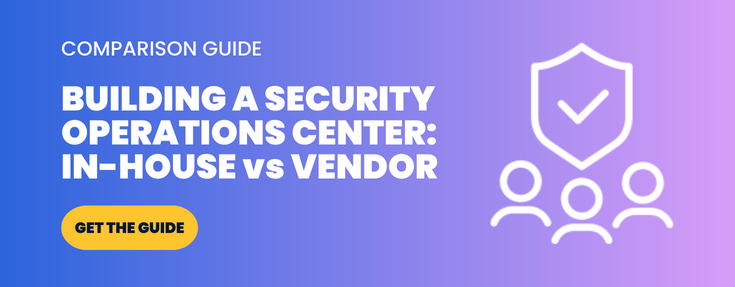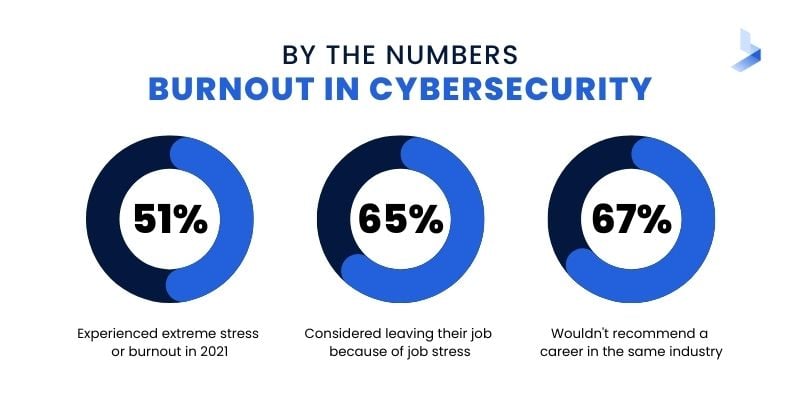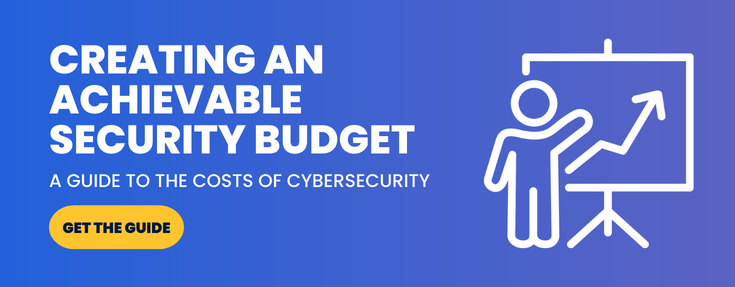Creating a Resilient Cybersecurity Strategy: How to Do More with Less

 By
Emily Miller
·
11 minute read
By
Emily Miller
·
11 minute read
For many, 2022 was a sobering year for cybersecurity. High-profile attacks and data breaches became increasingly common, exposing vulnerabilities in both public and private sector organizations. This stark reality has highlighted the need for robust cybersecurity measures, driving IT leaders to reevaluate their cybersecurity strategies and invest in cutting-edge solutions that protect their digital assets and maintain operational resilience in the face of evolving threats.
Cybersecurity is a stressful occupation that demands everything a professional has to offer. Even as the Great Resignation begins to wane in many industries, a skills shortage is very prevalent in cybersecurity as burnout severely impacts the industry.
If recent years have proven anything, it's that the cyberattack landscape is always growing. Predictions for 2023 and beyond suggest an escalation of existing trends along with dangers we haven't experienced in the past. The continual increase and escalation of ransomware are practically guaranteed because of the limited effort and impressive reward for hackers. Insider threats like business email compromise and credential theft are expected to grow in complexity with the addition of deep fake technology.
Other potential threats include predictions that nation-state attacks will worsen with the help of for-hire cybercriminals, and attacks will target satellite networks to cause major disruptions. For dedicated IT and cybersecurity managers, the question becomes how to stay ahead of the current threats and do more with even fewer resources. This guide explores the top issues plaguing IT managers and CISOs in 2023 and offers actionable advice to remain resilient even amidst continued budget cuts and breaches.
Making the Most of Shrinking Security Teams
As a cybersecurity or IT professional, it's easy to understand the dangers of a skills shortage in cybersecurity. Every network that accesses the internet is at risk. This means all levels of government, every type of business, healthcare systems and facilities, and critical infrastructure that provides individuals with water, heat, and food could be compromised. A global talent shortage isn't just a problem for IT professionals. It will quickly become a critical problem for everyone.
As companies and organizations recognize their cybersecurity needs, recruiting and retaining cybersecurity professionals becomes more difficult than ever. In a recent study, 63% of respondents reported unfilled cybersecurity positions, and 1 in 5 say it takes more than six months to find qualified candidates to fill empty positions. Furthermore, 60% have difficulty retaining qualified cybersecurity professionals. Reasons for turnover include:
- 59% were recruited by other companies
- 48% receive poor financial incentives
- 47% have limited promotion and development opportunities
- 45% experienced high work stress levels
- 34% suffered because of a lack of management within the organization
For IT managers and CISOs, recruitment is more expensive and time-consuming than ever. For industry professionals, shrinking teams and larger workloads are becoming too much to bear. For small IT and cybersecurity teams, sourcing talent can be even more difficult due to the lack of resources compared to bigger companies. As a result, members of short-staffed teams are facing longer hours, heavier workloads, and dangerous levels of stress.
How to Increase Your Security Headcount without Hiring Additional Staff
Cybersecurity is a human-led profession and no amount of tools can make up for a shortage of professionals on your team. Yet, the demands of recruiting and retaining in-house professionals can be impossible in the current landscape. When IT teams are faced with more than they can possibly accomplish, they need a trusted partner that can handle the rigors of modern cybersecurity. managed detection and response (MDR) supplied by a professional vendor provides your internal team with the professional assistance they need along with modern tools to enhance your cybersecurity posture. MDR is designed to be customized to the needs of an organization so off-site professionals work as an extension of your existing team, providing as much or as little assistance as you need.
| Related Reading: 7 Solutions for Combatting the Cybersecurity Talent Shortage |
Securing an Ever-Expanding Network
Technology is evolving at an unprecedented rate. As businesses keep up with the demands of consumers, organizational networks grow and change. In many sectors, like manufacturing and public utilities, cybersecurity concerns were minimal in the past. However, the dependence on IoT devices is growing and network vulnerabilities are growing along with it.
Alongside increased IoT use in a variety of industries, remote and hybrid work models are the new normal. Instead of depending on a close-knit company network, employees are working from devices on open Wi-Fi networks at home. On top of these concerns for cybersecurity professionals, the growth of personal device use affects organizational security as well. When employees use personal devices for work use, they aren't likely to follow the same security protocols as with company devices.
When surveyed, 77% of business leaders said they believe remote work poses a great cybersecurity risk to the business, and 66% said they find it significantly harder to monitor their online infrastructure with everyone working from home. Even worse, 25% have left their network largely unmonitored, leaving the company vulnerable to an attack. For cybersecurity professionals, these network expansions only add more tasks to an already overflowing workload.
Applying Integrated End-to-End Security
Today's modern enterprises demand a security system with endpoint detection and response (EDR). Endpoints are all the devices that connect to your network. EDR is a cybersecurity solution that offers detection, response, investigation, and remediation for threats that target endpoints. For the most effective solution, EDR should be integrated with your overall cybersecurity efforts for complete visibility across your entire network. Here at BitLyft, our managed detection and response solution utilizes some of the leading SIEM tools which collect data from all sources to be viewed in a centralized dashboard. As a result, your endpoints are protected on a scalable level.
Growing Ransomware Attacks
Ransomware attacks rose by 92.7% in 2021 compared to 2020 levels, with 1,389 reported attacks in 2020 and 2,690 in 2021. Ransomware attacks are profitable and offer a low-risk threshold for attackers. As a result, ransomware is likely to continue to grow in the future. As Ransomware as a Service (RaaS) provides ways for even those without tech experience to launch successful attacks, the practice is expected to grow and evolve. Techniques like double extortion and hackers selling information about companies they've successfully breached will lead to multiple attacks resulting from a single breach.
Preparedness is Critical with Effective Incident Response
In the modern threat landscape attempting to block threats simply isn't enough. IT professionals must be prepared to recognize threat actors actively moving within a network and take effective action immediately. Sophisticated attackers use multiple techniques to breach, infiltrate, and carry out an effective attack on a network. By the time a ransom is demanded, the damage is already done. Investing in MDR security with advanced next-gen SIEM, security automation capabilities, UEBA, and 24/7 oversight by trained cybersecurity professionals is the best way to achieve complete visibility into your network and provide real-time threat mitigation to stop active attackers. Since the service is billed on a monthly basis, it's prepared to scale to new network needs and changes like cloud migration.
| Related Reading: What is a Security Incident Response Plan? |
Wrangling an Abundance of Cybersecurity Tools
.png?width=300&height=300&name=Average%20Tools%20Used%20by%20Security%20Teams%20(1).png) The cyberthreat landscape is growing in all directions for a variety of different reasons. To keep up with the threats, tools are evolving just as quickly. There are hundreds of cybersecurity tools and software offerings available to solve different issues. As IT managers attempt to remain within budget and address all potential risks, buying a single tools instead of implementing a new system can be a workable option. Unfortunately, this can mean your team is faced with a giant toolbox of solutions and only a few professionals to use them. Organizations employ an average of 29 different security monitoring tools, and large organizations (with more than 10,000 employees) use an average of 46 different tools. While more tools should equal greater safety, too many tools can lead to reduced security. Tool sprawl occurs when an organization has too many tools to use effectively. Consider these issues cybersecurity teams face as a result of having too many tools to choose from.
The cyberthreat landscape is growing in all directions for a variety of different reasons. To keep up with the threats, tools are evolving just as quickly. There are hundreds of cybersecurity tools and software offerings available to solve different issues. As IT managers attempt to remain within budget and address all potential risks, buying a single tools instead of implementing a new system can be a workable option. Unfortunately, this can mean your team is faced with a giant toolbox of solutions and only a few professionals to use them. Organizations employ an average of 29 different security monitoring tools, and large organizations (with more than 10,000 employees) use an average of 46 different tools. While more tools should equal greater safety, too many tools can lead to reduced security. Tool sprawl occurs when an organization has too many tools to use effectively. Consider these issues cybersecurity teams face as a result of having too many tools to choose from.
- Some tools simply don't get used because there is a lack of integration or professional skills.
- Many tools aren't integrable. As a result, they limit each other's capabilities or require too much professional attention.
- Redundant alerts (the same alert from multiple tools) lead to alert fatigue.
How to Deploy a Fully Integrated Cybersecurity Solution
Building an effective cybersecurity solution with separate tools would likely be impossible. Even if you could build a stack that integrates successfully, you'd likely have more tools than your team could effectively use. For this reason, 92% of businesses facing cybersecurity tool sprawl have considered managed services to outsource detection and response capabilities. Billed on a monthly basis, MDR offerings can provide a single, unified version of truth to eliminate redundant alerts. Outsourced MDR addresses the dangers of tool sprawl with a predefined cybersecurity stack that works as a singular solution for a full range of cybersecurity needs.
Dealing with the Damaging Effects of Burnout
Companies in all industries faced drastic changes during pandemic restrictions. As employees were thrown into remote work in mass numbers, cybersecurity and IT professionals navigated the technological changes associated with expanding organizational networks. This effort wasn't without sacrifice, requiring larger workloads and increased hours. Even as organizations reached a "new normal" with remote and hybrid work arrangements, IT experts faced increased work and stress due to new network requirements and threats.
Security professionals already working in a high-stress environment forced to take on additional responsibilities and longer work hours are more likely to experience burnout. In 2021, 51% of cybersecurity professionals experienced extreme stress or burnout, and 65% considered leaving their job because of job stress. Burnout in cybersecurity can have a major impact on job performance leading to increased vulnerability. It also leads to increased turnover, further shrinking the talent pool.

Address Key Burnout Causes with Multiple Solutions
Unfortunately, there is no immediate solution to the critical talent shortage in the cybersecurity industry. However, there are various solutions that security experts can use to address the issues that cause burnout. Alert fatigue caused by multiple security tools, poor integration, and failed system optimization leads to increased stress and burnout. Investing in automated tools designed to prioritize alerts can eliminate time-consuming manual tasks to allow security professionals to concentrate on more important requirements. Managed services supplied by cybersecurity vendors include assistance from an off-site team of professionals who act as an extension of your team. This assistance can alleviate the increased work hours and workloads of understaffed teams. MDR security addresses all of these issues with a comprehensive solution that addresses many of the causes of burnout in the cybersecurity sector.
| Related Reading: 5 Ways to Beat Burnout in Cybersecurity |
Concerns About Looming Budget Cuts
Organizations are experiencing more cybersecurity threats, yet budget cuts are always a concern. As businesses across multiple industries struggle to recover from pandemic losses, budget cuts are inevitable. IT managers are constantly faced with the responsibility of defending the costs of effective cybersecurity. Budget cuts in an already underfunded industry could lead to critical vulnerabilities. Yet, failed investments could lead to declined budget requests in the future. If you're facing an upcoming budget meeting, it's essential to be prepared.
Prepare to Defend Your Budget with Research-Backed Information
Budget meetings require precise explanations to clarify why something is required and the ROI the product or service will offer. In cybersecurity, there are ways to improve your security posture while saving money. MDR security provides services that target modern cyberthreats as well as many of the issues faced by cybersecurity teams today. This includes end-to-end services for threat detection, response, investigation, and remediation. Along with a predefined security stack and automated responses, MDR provides 24/7 support from a dedicated off-site SOC.
| Related Reading: Cybersecurity Budget Guide: Get What You Need, Protect What You Have |
Fearing Potential Supply Chain Attacks
By exploiting a supply chain link, threat actors have the potential to reach hundreds or even thousands of victims. The Solarwinds attack clearly highlighted this threat and even spurred new federal regulations. More recently, the Log4j vulnerability exposed the potential reach of supply chain attacks and the difficulties following discovery. For instance, applying relevant patches is critical, but cybersecurity professionals still face the time-consuming task of combing through records for evidence a breach has already occurred.
A recent survey indicates that around 80% of organizations have experienced a cyberattack due to hidden vulnerabilities and loopholes in their supply chain. Effective security must have the ability to identify threats that lurk in cloud-based apps, supply chain connections, and software companies depend on to complete daily tasks.
Invest in Effective Protection that Includes Third Party Installations
To meet the demands of consumers and keep up with the fast-paced nature of modern business, organizations must depend on services provided by other companies. Yet, to avoid taking on added network vulnerabilities in the process, your security must secure access both externally and internally. Securing access begins with a zero-trust approach that only allows network users to access the resources they need to accomplish the parameters of their responsibilities. When privileged accounts are only held by a few administrators, dangerous activity and credential theft are easier to spot.
Along with using best practices to keep information secure, your existing security system should offer the same visibility and security for third-party applications as it provides for the rest of your network. By setting and implementing a cloud strategy across your entire organization to protect your infrastructure assets, you can have improved control over potential third-party risks.
Preparing for Evolving Compliance Requirements
Recent attacks have finally made it clear that effective cybersecurity is a necessity for all modern organizations. As the potential dangers of a catastrophic attack on critical infrastructure or food supplies come to light, it's clear that organizations must follow stricter regulations. To meet such regulations, many organizations will be forced into a long-needed cybersecurity makeover, but this will require extensive work for cybersecurity and IT professionals. Gaining new industry certifications is a complex and time-consuming process that must follow specific requirements. Mistakes can easily be made and each step must be documented to pass required audits and prove ongoing compliance. For IT professionals with a full workload, completing these extra tasks will likely be impossible.
Assess Your Organization's Posture and Close the Gap
To understand exactly how much work needs to be done, it's essential to know where you stand. Your team will need to assess your organization's current cybersecurity posture and determine exactly what must be accomplished before the certification deadlines. The process is complex and requires many steps. By hiring a third-party security provider to identify gaps, monitor systems, and provide essential response activity, you can prepare your organization for new certification requirements. An established security provider can provide you with the tools, professionals, and planning to complete your cybersecurity assessment, create a certification plan, and achieve your goals before deadlines arrive.
Facing User Resistance
Increased threats, remote work, and increasing compliance regulations lead to increased work for IT and cybersecurity specialists. These changes also bring about new requirements for network users. Security protocols (especially new ones) can be time-consuming and complicated to learn for users accustomed to a particular workflow. As a result, cybersecurity requirements are rarely welcomed with open arms. In fact, IT professionals face additional pressure from company leaders and network users to limit security protocols and restrictions. Since security restrictions affect end users, 80% of IT teams experience pushback when enforcing an organization's security policy. Even worse, 80% of IT teams said that IT security has become a thankless task, and 91% felt pressure to compromise security for business continuity. In organizations where security protocols are enforced, some users find workarounds like the use of unapproved third-party software or personal device use, to maintain productivity and convenience. These practices open organizational networks to vulnerabilities the security team is completely unaware of.
Introducing Effective and Convenient Security
The truth is, the most effective security systems can streamline processes and eliminate extra steps that are needed to satisfy multiple systems. When organizations adopt an end-to-end security system with tools designed to work together, security requirements are simplified to a single method like multi-factor identification. While replacing legacy systems is a big step for an organization, modern, cloud-based protection offers seamless protection that encompasses the entire network. By investing in managed cloud services like MDR your organization can achieve more effective protection that is integrated in a way that minimizes the requirements of network users.
Staying Ahead Instead of Keeping Up
There are many issues facing cybersecurity professionals that simply can't be solved overnight. The entire cyber landscape is changing. From the threats organizations face to the way employees work, organizational networks are performing in new ways. As a result, how we protect these networks must change as well. Under the current circumstances, it's impossible for IT and cybersecurity professionals to get ahead or even keep up with modern cybersecurity threats by just working harder. Cybersecurity teams are already at their capacity or far beyond it, and still struggling to move forward.
The modern threat landscape requires a full team of experienced professionals providing critical services 24/7/365 and a comprehensive system that provides complete visibility and automated actions for effective threat detection, response, investigation, and remediation. To accomplish this, most organizations will need the services of a professional managed detection and response vendor. MDR isn't a tool. It's a collection of services tailored to your organization and installed by your provider. Furthermore, MDR security has the crucial requirement of including ongoing assistance through routine and emergency communication with off-site security professionals. MDR stands out in a sea of tools and services as a single solution to the modern cybersecurity threat landscape.
At BitLyft, our answer to modern cybersecurity threats is called BitLyft AIR®. A single turnkey solution that goes above and beyond traditional MDR services, BitLyft AIR® provides fully integrated features like EDR and UEBA included in the SIEM system. With direct access to the dedicated cybersecurity professionals in your off-site SOC who know your environment and unique organizational goals, you get a true extension of your internal team and a way to increase cybersecurity headcount in a competitive hiring market.
Schedule a 30-minute demo to learn more about how we can help you stay sane while providing effective and affordable cybersecurity for your organization in today's growing cyberthreat landscape.
